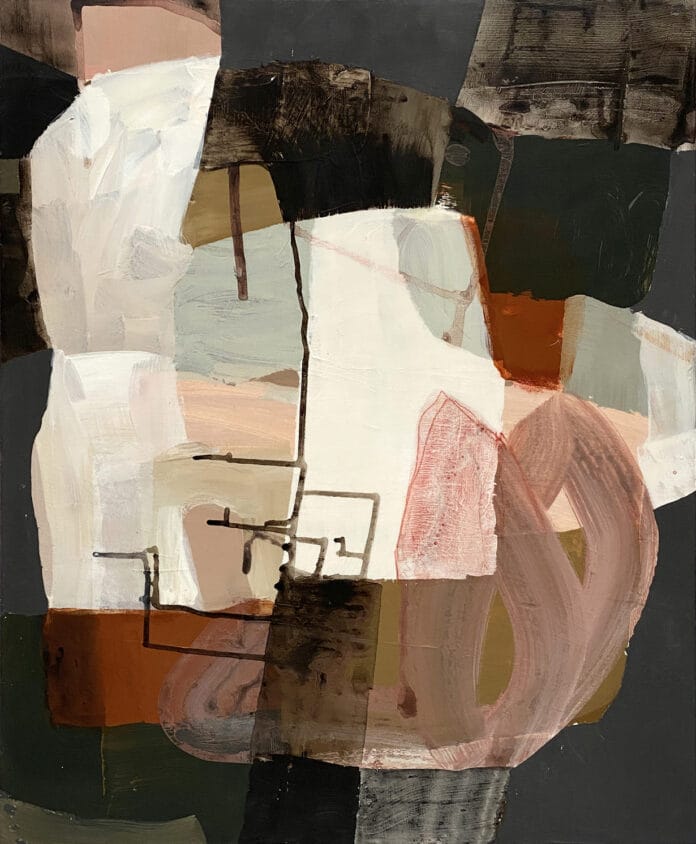Terri Froelich is a contemporary abstract painter and photographer based in Sausalito, California. Her studio, located in the historic Industrial Center Building (ICB), is where she channels decades of visual exploration into layered, textural artworks. From a young age, Froelich was drawn to photography, particularly the tactile, precise qualities of film. But as digital photography became the norm, she found herself seeking a more hands-on, intuitive mode of creative expression.
This search led her to begin painting with her photographs in 2002—initially through collages that used her own photographic images. Over time, these pieces evolved into mixed media paintings that often hint at photographic origins but are rooted firmly in abstraction.
Evolving from Collage to Mixed Media Abstraction
Froelich’s early works featured carefully composed photo collages that emphasized form, rhythm, and contrast. As her practice matured, the emphasis shifted away from the photographic source material and toward paint, texture, and mark-making. Today, her paintings may contain traces of photography, but they serve primarily as abstract constructions of color, balance, and visual tension.
This evolution reflects a deeper creative philosophy: embracing experimentation, resisting predictability, and allowing each body of work to unfold naturally. The process is both structured and intuitive—allowing Froelich to respond to each canvas in the moment, rather than imposing a fixed plan.
Inspired by Industrial and Maritime Landscapes
Froelich draws significant inspiration from her surroundings, particularly the maritime and industrial elements of the Bay Area. Her frequent walks near docks, shipyards, and weathered buildings offer endless visual material—chipped paint, rusted surfaces, exposed steel, and shifting reflections.
While her paintings are not literal depictions of these places, they capture the essence of them through abstract visual language. Her ability to extract beauty from overlooked and utilitarian structures transforms the ordinary into something lyrical and emotionally resonant.
A Bold Exploration of Color and Shape
Color is a driving force in Froelich’s work. Each piece is an exploration of balance and friction—where vibrant hues collide, blend, and settle into harmony. She often works with palettes that challenge her instincts, deliberately pushing beyond her comfort zone to discover new relationships between colors.
Equally important are the shapes and lines that define her compositions. Froelich often juxtaposes hard-edged geometric forms with loose, gestural marks, creating a dialogue between structure and spontaneity. This interplay of control and release is a defining characteristic of her visual style.
From Photography to Abstraction: A Fluid Process
Though she no longer directly incorporates photographic prints into most of her paintings, Froelich continues to use photography as a creative tool. Her camera serves as a way to capture visual moments—textures, light, lines, and compositions—that later influence her studio work.
Rather than serving as blueprints, these photographs become visual notes, inspiring color palettes, compositions, or textures. In the studio, she layers acrylics, graphite, pastel, and other materials to build up each painting. The result is work that feels both grounded and abstract, rich with visual memory yet free of literal references.
Recognition and Gallery Representation
Terri Froelich’s work has been widely recognized and exhibited in galleries across the United States and internationally. Her abstract paintings have been featured in juried exhibitions, received awards, and are part of museum and private collections. She is represented by Julie Nester Gallery in Park City, Kennedy Contemporary in Newport Beach, and Slate Contemporary in Oakland.
Collectors and curators alike are drawn to the emotional depth and formal sophistication in her work—qualities that continue to evolve as she explores new directions in her practice.
A Lasting Visual Voice
Froelich’s paintings reflect a deep engagement with process, material, and visual observation. Whether drawing from industrial decay or natural weathering, she transforms surface and structure into something contemplative, abstract, and timeless.
Her work invites viewers to look closely—to appreciate the subtle dialogue between chaos and order, texture and space, color and silence. As she continues to evolve, Terri Froelich remains a vital voice in contemporary abstraction, offering a body of work that is as visually rich as it is emotionally resonant.


